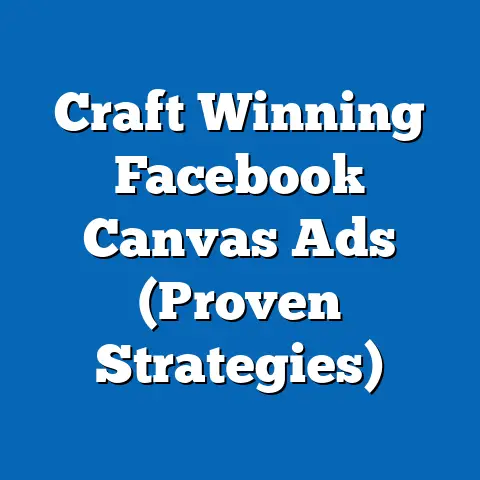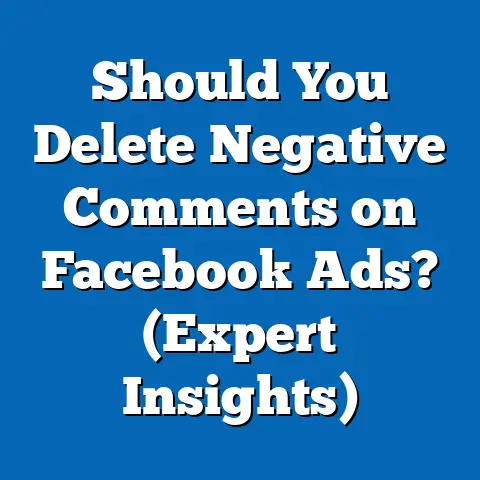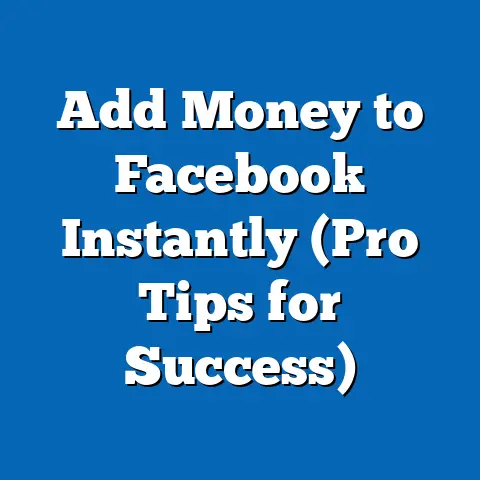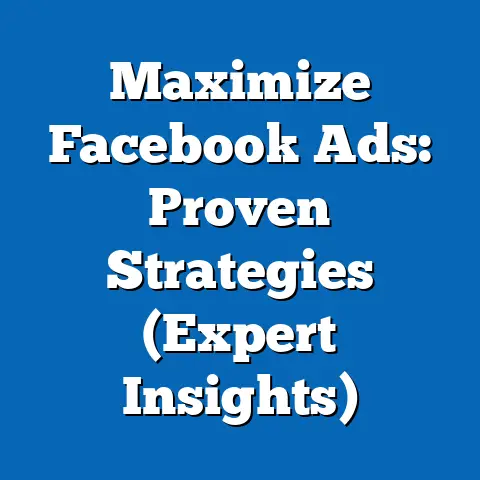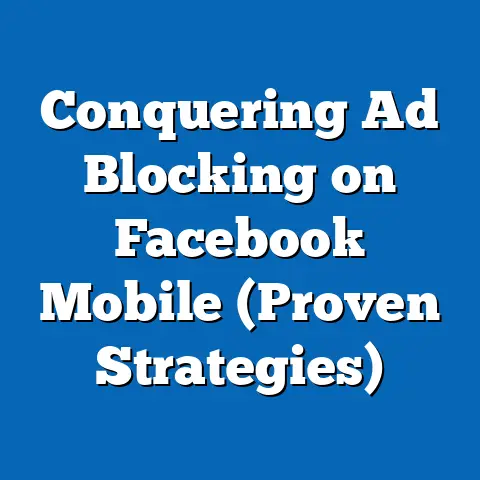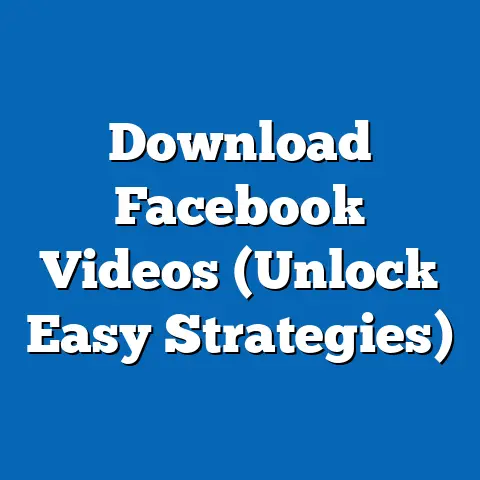Craft Captivating Facebook Video Ads (Expert Tips Inside)
I’ve spent years immersed in the world of Facebook advertising, and one thing has become abundantly clear: video is king. But not just any video. To truly cut through the noise and grab the attention of your target audience, you need to craft captivating video ads that resonate deeply. This isn’t just about slapping together a quick clip; it’s about understanding your audience, mastering the art of storytelling, and leveraging the technical capabilities of the Facebook platform.
Imagine you’re scrolling through your Facebook feed. What makes you stop? Is it a catchy jingle? A visually stunning scene? Or perhaps a story that tugs at your heartstrings? The key to successful Facebook video ads lies in understanding what motivates your audience and then crafting content that speaks directly to their needs and desires.
Key Takeaways:
- Video is King: Video ads are incredibly effective on Facebook, offering high engagement and conversion rates.
- Know Your Audience: Understanding your target audience is crucial for creating relevant and engaging video content.
- Storytelling Matters: Craft compelling stories that resonate emotionally with your audience.
- Optimize for Mobile: Most Facebook users watch videos on their mobile devices, so optimize your ads accordingly.
- Test and Iterate: Continuously test different ad creatives and targeting options to improve performance.
Section 1: Understanding Your Audience
Before you even think about filming a single frame, you need to understand who you’re talking to. This is the foundation of any successful marketing campaign, and Facebook video ads are no exception. It’s not enough to simply create a visually appealing video; it needs to resonate with your target audience on a personal level.
Identify Your Target Audience
Knowing your audience demographics, interests, and behaviors is paramount. This information will guide your creative decisions, from the tone and style of your video to the messaging and call to action.
- Demographics: Age, gender, location, education level, income, and occupation are all important demographic factors to consider.
- Interests: What are your audience’s hobbies, passions, and interests? What pages do they like on Facebook? What groups are they members of?
- Behaviors: How do they interact with Facebook? What types of content do they engage with? What devices do they use?
Facebook Audience Insights: Your Secret Weapon
Facebook Audience Insights is a powerful tool that allows you to gather valuable data about your target audience. You can access it through the Facebook Ads Manager.
Here’s how I use it:
- Define Your Audience: Start by defining your audience based on demographics, interests, and behaviors.
- Explore Insights: Explore the various insights provided by Facebook, such as top categories, page likes, location, and device usage.
- Refine Your Targeting: Use this information to refine your targeting options in your Facebook ad campaigns.
For example, let’s say you’re selling organic skincare products. Using Facebook Audience Insights, you might discover that your target audience is primarily women aged 25-45 who are interested in natural beauty, wellness, and sustainability. They are also likely to follow brands like Whole Foods Market and Dr. Bronner’s.
With this information, you can create video ads that specifically address the needs and interests of this audience. You might showcase the natural ingredients in your products, highlight their eco-friendly packaging, or feature testimonials from satisfied customers who share similar values.
Tailoring Content
Once you have a clear understanding of your target audience, you can start tailoring your video content to resonate with them. This means crafting videos that speak directly to their needs, desires, and pain points.
- Address Their Needs: Identify the specific problems or challenges that your target audience faces and show how your product or service can help solve them.
- Highlight the Benefits: Focus on the benefits of your product or service rather than just the features. How will it make their lives better?
- Use Their Language: Use language and terminology that your target audience will understand and relate to. Avoid jargon or technical terms that might confuse them.
Real-World Example:
I once worked with a local gym that was struggling to attract new members. After conducting thorough audience research, we discovered that their target audience was primarily busy professionals who were looking for a convenient and effective way to stay in shape.
Based on this insight, we created a series of video ads that showcased the gym’s quick and efficient workout routines, its convenient location, and its friendly and supportive atmosphere. The ads also featured testimonials from existing members who shared similar experiences.
The result? A significant increase in gym memberships and a boost in brand awareness. By tailoring the video content to the specific needs and interests of the target audience, we were able to create a campaign that resonated deeply and drove real results.
Creating Emotional Connections
Video is a powerful medium for creating emotional connections with your audience. By tapping into their emotions, you can build trust, loyalty, and ultimately, drive conversions.
- Tell a Story: People love stories. Craft a compelling narrative that will capture their attention and keep them engaged.
- Evoke Emotions: Use visuals, music, and voiceovers to evoke emotions such as joy, sadness, excitement, or inspiration.
- Show Authenticity: Be genuine and authentic in your videos. People can spot a fake a mile away.
Expert Strategies for Storytelling:
- Identify the Core Message: What is the main message you want to convey?
- Create a Protagonist: Who is the hero of your story?
- Introduce a Conflict: What challenges does the protagonist face?
- Offer a Resolution: How does your product or service help the protagonist overcome their challenges?
- End with a Call to Action: What do you want viewers to do after watching your video?
I remember working on a campaign for a non-profit organization that provided clean water to communities in developing countries. We created a series of video ads that told the stories of real people who had been impacted by the organization’s work.
The videos were incredibly powerful and moving, and they generated a huge outpouring of support. People were touched by the stories they saw and felt compelled to donate to the organization’s cause.
The key to success was the emotional connection we were able to create with the audience. By sharing authentic stories and showcasing the real-world impact of the organization’s work, we were able to inspire people to take action.
Takeaway:
Understanding your audience is the foundation of any successful Facebook video ad campaign. Use Facebook Audience Insights to gather valuable data about your target audience and then tailor your video content to resonate with their needs, desires, and emotions.
Section 2: Crafting the Perfect Video
Now that you have a deep understanding of your target audience, it’s time to start crafting the perfect video. This involves careful consideration of video length, format, visual and audio elements, and the all-important hook.
Video Length and Format
The optimal length for Facebook video ads depends on several factors, including your target audience, your message, and your advertising goals. However, as a general rule, shorter videos tend to perform better.
- Shorter is Better: Studies have shown that videos shorter than 15 seconds tend to have higher completion rates and engagement rates.
- Mobile Optimization: Most Facebook users watch videos on their mobile devices, so optimize your videos for mobile viewing. This means using a vertical or square format and ensuring that the text is legible on smaller screens.
Why Shorter Videos Often Perform Better:
- Attention Spans: People’s attention spans are getting shorter and shorter, especially on social media.
- Mobile Viewing: People are often watching videos on their mobile devices while they’re on the go.
- Information Overload: There’s so much content competing for people’s attention on Facebook.
Various Formats and Their Impact:
- Square (1:1): This format is ideal for mobile viewing and tends to perform well in the Facebook feed.
- Vertical (9:16): This format is perfect for Facebook Stories and Reels.
- Landscape (16:9): This format is best suited for desktop viewing and can also be used in the Facebook feed.
I’ve found that square videos are generally a safe bet for Facebook video ads. They work well on both desktop and mobile and they tend to be more engaging than landscape videos. However, if you’re creating content specifically for Facebook Stories or Reels, then vertical videos are the way to go.
Visual and Audio Elements
High-quality visuals and sound are essential for capturing attention and keeping viewers engaged. If your video looks and sounds amateurish, people are likely to scroll right past it.
- Invest in Quality: Invest in good lighting, a decent camera, and a high-quality microphone.
- Use Visual Effects: Use visual effects such as motion graphics, animations, and transitions to add visual interest to your videos.
- Choose the Right Music: Choose music that is appropriate for your brand and your message. Avoid using copyrighted music without permission.
- Add Sound Effects: Use sound effects to enhance the impact of your videos.
Tips on Selecting the Right Music, Voiceovers, and Sound Effects:
- Consider Your Brand: Choose music that is consistent with your brand’s personality and style.
- Match the Tone: Select music that matches the tone and mood of your video.
- Use Royalty-Free Music: There are many websites that offer royalty-free music and sound effects that you can use in your videos.
- Hire a Professional Voiceover Artist: If you need a voiceover for your video, consider hiring a professional voiceover artist.
I once made the mistake of using low-quality audio in a video ad. The video itself was visually appealing, but the sound was muffled and distorted. As a result, the ad performed poorly and I wasted a lot of money.
Lesson learned: Don’t skimp on audio quality! It’s just as important as the visuals.
Creating a Strong Hook
The first few seconds of your video are crucial for retaining viewer interest. If you don’t grab their attention within the first three seconds, they’re likely to scroll on.
- Ask a Question: Start with a question that is relevant to your target audience.
- Make a Bold Statement: Make a bold statement that will pique their curiosity.
- Show a Compelling Visual: Show a visually stunning scene that will capture their attention.
- Tease a Benefit: Tease a benefit that your product or service offers.
Strategies for Creating Hooks That Grab Attention Immediately:
- Focus on the Problem: Start by highlighting the problem that your target audience is facing.
- Offer a Solution: Immediately offer a solution to that problem.
- Show the Result: Show the positive result that viewers can achieve by using your product or service.
I’ve found that using a combination of visuals and audio is the most effective way to create a strong hook. For example, you might start with a visually stunning scene accompanied by a catchy jingle or a thought-provoking question.
Takeaway:
Crafting the perfect video involves careful consideration of video length, format, visual and audio elements, and the hook. Optimize your videos for mobile viewing, invest in high-quality visuals and sound, and create a strong hook that will grab viewers’ attention within the first few seconds.
Section 3: Writing Compelling Copy
While the visual aspect of video ads is undeniably important, the accompanying copy plays a crucial role in driving engagement and conversions. Compelling copy can amplify your message, clarify your offer, and persuade viewers to take action.
Crafting a Compelling Script
A strong script is the backbone of any successful video ad. It should be clear, concise, and engaging, and it should effectively communicate your message to your target audience.
- Start with a Clear Objective: What do you want viewers to do after watching your video?
- Keep it Short and Sweet: Get to the point quickly and avoid rambling.
- Use a Conversational Tone: Write in a way that is natural and easy to understand.
- Focus on Benefits: Highlight the benefits of your product or service rather than just the features.
- Include a Call to Action: Tell viewers exactly what you want them to do.
Elements of a Strong Script:
- Hook: Grab viewers’ attention within the first few seconds.
- Problem: Identify the problem that your target audience is facing.
- Solution: Offer a solution to that problem.
- Benefits: Highlight the benefits of your product or service.
- Call to Action: Tell viewers what you want them to do.
Examples of Successful Scripts and Analysis:
- Dollar Shave Club: Their original video was hilarious, memorable, and clearly communicated their value proposition.
- Old Spice: Their “The Man Your Man Could Smell Like” campaign was witty, engaging, and perfectly targeted their audience.
I once worked with a client who was selling a new type of coffee maker. Their initial script was full of technical jargon and focused on the features of the product. As a result, the video ad performed poorly.
We rewrote the script to focus on the benefits of the coffee maker, such as its ease of use, its ability to brew delicious coffee quickly, and its sleek and modern design. We also used a more conversational tone and included a clear call to action.
The result was a dramatic improvement in performance. The video ad generated more leads, more sales, and more brand awareness.
Call to Action (CTA)
A clear and persuasive CTA is essential for driving conversions. It tells viewers exactly what you want them to do after watching your video.
- Be Specific: Tell viewers exactly what you want them to do (e.g., “Visit our website,” “Sign up for a free trial,” “Download our app”).
- Make it Easy: Make it easy for viewers to take action by including a link in the video description or using Facebook’s built-in CTA buttons.
- Create a Sense of Urgency: Use language that creates a sense of urgency (e.g., “Limited time offer,” “Don’t miss out,” “Sign up today”).
- Test Different CTAs: Experiment with different CTAs to see which ones perform best.
Examples of Effective CTAs:
- Shop Now: Perfect for e-commerce businesses.
- Learn More: Ideal for educational content or lead generation.
- Sign Up: Great for building an email list or offering a free trial.
- Download: Useful for promoting apps or ebooks.
I’ve found that using a combination of visual and audio cues can be very effective for driving clicks on CTAs. For example, you might highlight the CTA button with a bright color or use a voiceover to encourage viewers to click.
Testing and Iterating
A/B testing is crucial for optimizing your video ad campaigns. It allows you to test different scripts, formats, and CTAs to see what resonates best with your audience.
- Test One Variable at a Time: When A/B testing, make sure to test only one variable at a time. This will allow you to isolate the impact of that variable on performance.
- Use Facebook’s A/B Testing Tool: Facebook offers a built-in A/B testing tool that makes it easy to test different ad creatives and targeting options.
- Analyze Performance Metrics: Pay close attention to performance metrics such as views, engagement rates, and conversions.
- Refine Your Messaging: Use the data you collect to refine your messaging and improve your ad creatives.
Insights Into Analyzing Performance Metrics:
- Views: How many people are watching your video?
- Engagement Rates: How are people interacting with your video (e.g., likes, comments, shares)?
- Conversions: How many people are taking the desired action (e.g., visiting your website, signing up for a free trial)?
I always recommend starting with a few different versions of your video ad and then running A/B tests to see which one performs best. Once you’ve identified a winning ad, you can continue to refine it by testing different elements such as the headline, the description, and the CTA.
Takeaway:
Writing compelling copy is essential for driving engagement and conversions. Craft a strong script that is clear, concise, and engaging, and include a clear and persuasive CTA. Use A/B testing to optimize your video ad campaigns and continuously refine your messaging.
Section 4: The Technical Side of Video Ads
Creating captivating video ads isn’t just about the creative aspects; it also requires a solid understanding of the technical side of things. This includes video production basics, optimizing for Facebook, and utilizing Facebook Ad Manager effectively.
Video Production Basics
You don’t need to be a professional filmmaker to create high-quality video ads, but you do need to have a basic understanding of video production principles.
- Lighting: Good lighting is essential for creating visually appealing videos.
- Sound: High-quality audio is just as important as the visuals.
- Camera: You don’t need an expensive camera to create great videos. A smartphone or a webcam can work just fine.
- Editing: Video editing software can help you polish your videos and add visual effects.
Essential Tools and Software:
- Video Editing Software: Adobe Premiere Pro, Final Cut Pro, iMovie
- Animation Tools: Adobe After Effects, Animaker, Biteable
- Screen Recording Software: Loom, Screencast-O-Matic, OBS Studio
DIY Video Production vs. Hiring Professionals:
- DIY: Cost-effective, allows for creative control, can be time-consuming.
- Hiring Professionals: Higher quality, saves time, can be expensive.
I’ve done both DIY video production and hired professionals, and I’ve found that both approaches have their pros and cons. DIY video production is a great option if you’re on a tight budget and you have the time and skills to create high-quality videos. However, if you’re looking for a more polished and professional look, then hiring professionals is the way to go.
Optimizing for Facebook
Facebook has specific technical requirements for video ads, such as resolution, aspect ratio, and file size. Optimizing your videos for Facebook will ensure that they look their best and load quickly.
- Resolution: Aim for a resolution of at least 1080p (1920×1080 pixels).
- Aspect Ratio: Use a square (1:1) or vertical (9:16) aspect ratio for mobile viewing.
- File Size: Keep your file size as small as possible to ensure quick loading times.
- File Type: Use MP4 or MOV file types.
Tips on How to Optimize Videos for Quick Loading and Playback:
- Compress Your Videos: Use video compression software to reduce the file size of your videos without sacrificing too much quality.
- Use a Content Delivery Network (CDN): A CDN can help deliver your videos to viewers more quickly by caching them on servers around the world.
- Enable Autoplay: Enable autoplay to ensure that your videos start playing automatically when viewers scroll past them in their feed.
- Add Captions: Add captions to your videos to make them accessible to viewers who are watching with the sound off.
I always make sure to optimize my videos for Facebook before uploading them. This helps to ensure that they look their best and load quickly, which can improve engagement rates and conversions.
Utilizing Facebook Ad Manager
Facebook Ad Manager is a powerful tool that allows you to create, manage, and track your Facebook ad campaigns. It’s essential to understand how to use Ad Manager effectively to maximize the impact of your video ads.
- Create a Campaign: Start by creating a new campaign in Ad Manager.
- Choose Your Objective: Select an objective that aligns with your advertising goals (e.g., brand awareness, reach, traffic, engagement, leads, sales).
- Define Your Audience: Target your ads to the right people based on demographics, interests, and behaviors.
- Set Your Budget: Set a daily or lifetime budget for your campaign.
- Choose Your Placement: Select where you want your ads to appear (e.g., Facebook feed, Instagram feed, Audience Network).
- Create Your Ad: Create your video ad and write compelling copy.
- Track Your Results: Monitor your campaign’s performance and make adjustments as needed.
Step-by-Step Guide to Using Facebook Ad Manager:
- Go to Facebook Ad Manager: Access Ad Manager through your Facebook business page.
- Create a New Campaign: Click the “Create” button to start a new campaign.
- Choose Your Objective: Select an objective that aligns with your advertising goals.
- Define Your Audience: Create a custom audience or use Facebook’s targeting options.
- Set Your Budget and Schedule: Choose a daily or lifetime budget and set a start and end date for your campaign.
- Choose Your Placement: Select where you want your ads to appear.
- Create Your Ad: Upload your video and write compelling copy.
- Review and Publish: Review your ad settings and publish your campaign.
Targeting Options, Budgeting, and Scheduling for Maximum Impact:
- Targeting Options: Use Facebook’s detailed targeting options to reach the right people.
- Budgeting: Set a budget that aligns with your advertising goals and your target audience.
- Scheduling: Schedule your ads to run when your target audience is most active on Facebook.
I’ve found that using Facebook’s custom audiences and lookalike audiences can be very effective for targeting my video ads. Custom audiences allow you to target people who have already interacted with your business, while lookalike audiences allow you to target people who are similar to your existing customers.
Takeaway:
The technical side of video ads is just as important as the creative side. Understand video production basics, optimize your videos for Facebook, and utilize Facebook Ad Manager effectively to maximize the impact of your video ad campaigns.
Section 5: Analyzing Performance and Making Improvements
Creating captivating video ads is only half the battle. To truly succeed, you need to analyze your performance data and make continuous improvements to your campaigns.
Key Metrics to Track
Tracking the right metrics is essential for gauging the success of your video ad campaigns. Here are some of the most important metrics to track:
- Views: The number of times your video has been viewed.
- Engagement Rates: The percentage of viewers who have interacted with your video (e.g., likes, comments, shares).
- Completion Rate: The percentage of viewers who have watched your video all the way through.
- Click-Through Rate (CTR): The percentage of viewers who have clicked on your call to action.
- Conversion Rate: The percentage of viewers who have taken the desired action (e.g., visiting your website, signing up for a free trial, making a purchase).
- Cost Per View (CPV): The average cost you pay for each view of your video.
- Return on Ad Spend (ROAS): The amount of revenue you generate for every dollar you spend on advertising.
How to Interpret These Metrics:
- High Views, Low Engagement: This suggests that your video is visually appealing but not engaging enough.
- High Engagement, Low Conversions: This suggests that your video is resonating with your audience but not driving the desired action.
- Low Views, High Engagement: This suggests that your targeting is too narrow.
- High CPV: This suggests that your targeting is too broad or that your ad creative is not compelling enough.
- Low ROAS: This suggests that your advertising campaigns are not profitable.
I always create a dashboard to track my key metrics in real-time. This allows me to quickly identify areas for improvement and make adjustments to my campaigns as needed.
Adjusting Strategy Based on Data
Performance data is your best friend when it comes to optimizing your video ad campaigns. Use the data you collect to inform your future campaigns and make continuous improvements to your ad creatives, targeting options, and messaging.
- Identify Underperforming Ads: Identify ads that are not performing well and pause or replace them.
- Refine Your Targeting: Adjust your targeting options to reach a more relevant audience.
- Test New Ad Creatives: Experiment with different ad creatives to see what resonates best with your audience.
- Optimize Your Messaging: Refine your messaging to better communicate the benefits of your product or service.
- Adjust Your Budget: Allocate more budget to your best-performing ads and less budget to your underperforming ads.
Case Studies of Brands That Successfully Pivoted Their Strategy:
- Airbnb: They started by creating simple video ads that showcased their unique accommodations. They later pivoted to creating more emotional and storytelling-based ads that highlighted the experiences that travelers could have when staying in an Airbnb.
- Nike: They initially focused on creating ads that featured professional athletes. They later pivoted to creating ads that celebrated everyday athletes and encouraged people to get active.
I once worked with a client who was selling a mobile app. Their initial video ads were focused on the features of the app. However, after analyzing their performance data, we discovered that their target audience was more interested in the benefits of the app.
We rewrote the script to focus on the benefits of the app, such as its ability to save time, improve productivity, and help people stay organized. We also created new ad creatives that showcased the app in action.
The result was a significant improvement in performance. The video ads generated more downloads, more active users, and more revenue.
Staying Ahead of Trends
The world of video advertising is constantly evolving. To stay ahead of the curve, you need to stay up-to-date on the latest trends and best practices.
- Follow Industry Blogs and Publications: Stay informed about the latest trends and best practices by following industry blogs and publications.
- Attend Industry Events: Attend industry events to network with other marketers and learn from experts.
- Experiment with New Ad Formats: Experiment with new ad formats such as Facebook Reels and Instagram Stories.
- Stay Up-to-Date on Facebook’s Algorithm Changes: Facebook’s algorithm is constantly changing, so it’s important to stay up-to-date on the latest changes and how they impact your ad campaigns.
Emerging Trends in Video Advertising on Facebook:
- Short-Form Video: Short-form video content is becoming increasingly popular on Facebook.
- Live Video: Live video is a great way to engage with your audience in real-time.
- Personalized Video: Personalized video ads can be very effective for driving conversions.
- Interactive Video: Interactive video ads allow viewers to interact with your video and learn more about your product or service.
The Role of Innovation and Creativity in Staying Competitive:
- Think Outside the Box: Don’t be afraid to experiment with new ideas and approaches.
- Stay Authentic: Be genuine and authentic in your videos.
- Tell a Story: Craft compelling narratives that will capture viewers’ attention.
- Create Value: Provide value to your audience by creating informative and entertaining videos.
I always try to stay ahead of the curve by experimenting with new ad formats and techniques. This allows me to find new ways to reach my target audience and improve the performance of my campaigns.
Takeaway:
Analyzing performance data and making continuous improvements are essential for maximizing the impact of your video ad campaigns. Track the right metrics, adjust your strategy based on data, and stay ahead of the latest trends to remain competitive.
Conclusion
Crafting captivating Facebook video ads is a blend of creativity, strategy, and technical knowledge. It’s about understanding your audience, telling compelling stories, and leveraging the capabilities of the Facebook platform.
By following the expert tips and strategies outlined in this article, you can create video ads that not only capture attention but also drive real results. Remember to:
- Know your audience: Understand their needs, desires, and pain points.
- Tell a story: Craft compelling narratives that resonate emotionally.
- Optimize for mobile: Ensure your videos look great on smaller screens.
- Test and iterate: Continuously refine your campaigns based on performance data.
- Stay ahead of trends: Keep up with the latest innovations in video advertising.
I hope this guide has provided you with valuable insights and actionable strategies that you can implement in your own Facebook video ad campaigns. Remember, the key to success is to be creative, be strategic, and be persistent.
Now go out there and create some captivating video ads! The world is waiting to see what you’ve got.

